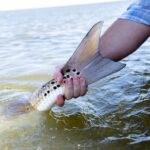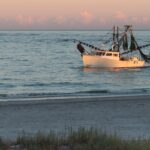
A Veteran Guide’s View of Jacks
If you’ve spent any time on the water in South Florida, chances are you’ve heard
As the reduction industry fights to take more fish in the Chesapeake, things get muddied
Originally Published Here on Fissues
By Capt. John McMurray
To those of us who fish, it seems so darn obvious.
If you take a HUGE amount of what by all accounts is a critically important forage source for, well, just about everything, out of a geographically specific area—in this case an extremely important one—it’s going to have an impact. A BIG impact.
I mean come on, how could it not?
But here we are, a week out from the spring Atlantic States Marine Fisheries Commission (ASMFC) meeting and we’re still having the same conversation.
The November Menhaden Board Meeting and VA’s appeal
For context, yes, back in November we pretty much got screwed by ASMFC. (For details see WITH MENHADEN, HERE’S WHAT WENT DOWN.)
The long and short of it is that instead of making the choice to manage menhaden explicitly for its role as forage. THIS year, the Menhaden Management Board (Board) decided to delay while it waited for the technical staff’s “ecological reference points,” supposedly forthcoming in 2019 and ready for management use in 2020 (although there are many who doubt this timeline).
While that was a bummer, what really stunk was that the Board also increased the overall quota by 8%, so that coastal states could get more fish for their bait operations, because Virginia had glommed onto 75% of the coastal quota for their large-scale/low value reduction fishery. This happened despite a huge public outcry to leave the quota alone, given the benefits that recent menhaden abundance has brought to coastal states (whales, striped bass, sharks etc.).
But Virginia’s “entitled” reduction industry wasn’t happy about that, because they didn’t get their 8% increase, even though in the end, due to transfers from states that weren’t able to use their quota, industry got a solid 7% increase. Still, they whined and moaned, got the prior Governor to appeal the decision, and threatened to go out of compliance if they didn’t get more fish.
The only good thing to come out of November’s meeting was a reduction in the overall Chesapeake Bay Cap (the number of fish the reduction industry can harvest out of Bay waters) from 87,000 metric tons to 51,000 metric tons.
Let me be clear that this wasn’t a particularly big win, because in practice we didn’t really reduce anything. All the Board did was adjust catch in the Bay to the most recent five-year average. In other words, the Board sought a precautionary approach, keeping catch where it is, avoiding further localized depletion in a critical area, without significantly impacting the reduction industry.
Of course, the reduction industry pushed the state to appeal this as well, and Virginia may indeed go out of compliance with the Chesapeake Bay Cap (Bay Cap).
To Virginia’s credit, the incoming Governor, Ralph Northam, who by most accounts seems to be a pretty good guy, yanked the appeal in February, right before ASMFC’s Policy Board was to meet to discuss it.
Subsequently, Governor Northam put forth legislation that would bring Virginia into compliance, specifically with the Bay Cap, but the Virginia legislature didn’t pass it. So, what happens now is anyone’s guess.
While this part is fuzzy to me, yes, technically the state could already be out of compliance. Last year’s Bay Cap quota currently doesn’t comply with ASMFC’s new directive, but it remains to be seen whether the reduction industry will actually exceed the ASMFC stipulated 51,000 metric ton cap this year.
Localized Depletion
Which leads us to the Chesapeake Bay localized depletion issue.
The reduction industry argues that the decision by the Board to cap Bay harvest at a five-year average isn’t based on science, and that localized depletion doesn’t and has never existed.
ASMFC initially put a Chesapeake Bay Cap in place well over a decade ago noting:
“The potential for localized depletion exists in Chesapeake Bay as a result of this concentrated harvest. Possible outcomes of localized depletion include compromised predator-prey relationships and chronic low recruitment of larval menhaden to the Chesapeake system.”
Since then, several major studies have taken place. But in the end, none of them could prove localized depletion was occurring. That’s partially because ASMFC defined localized depletion in the Chesapeake Bay as:
“A reduction in menhaden population size or density below the level of abundance that is sufficient to maintain its basic ecological (e.g. forage base, grazer of plankton), economic, and social/culture functions. It can occur as a result of fishing pressure, environmental conditions, and predation pressures on a limited spatial and temporal scale.”
Measuring the basic ecological, economic, and social/cultural functions is difficult. Depending on perspective, different people will come to different conclusions. And so past studies were inconclusive, not because evidence didn’t point to poor conditions in the Bay, but because of different stakeholders’ priorities in terms of economic and social/cultural function.
But what we do know is that there is evidence of food limitation for predators in the Bay—most notably, signs of poor health of striped bass. We know that there is science from around the world showing that large scale forage fish removals impact predators. It is a well-established fact that reduced prey abundance in critical foraging habitats can have a cumulative negative impact on reproductive output, fitness and survival of predator populations. We know that there is and has been low menhaden recruitment (production) in the Bay. We know that right now, industry can take 40% of the total coast-wide quota (87,000 metric tons) from one geographic area, and this particular area is an important nursery area for young menhaden, striped bass and other important species. We know that this is incredibly risky, and, well just plain stupid.
That should be more than enough information for the Board to make sound precautionary decisions when it comes to the Chesapeake Bay.
Yet the reduction industry is adamant that localized depletion is not occurring simply because the studies that were conducted were inconclusive. Like a spoiled child who just wants more, they are demanding an 87,000 metric ton quota, even though they haven’t come close to catching that in the last 5 years.
Let’s be clear: capping at an average and avoiding expansion as a precautionary measure—until we have better information—is common practice in fisheries management everywhere. And let’s also be clear—the Board has full discretion, as a deliberative management body, to take precautionary measures that seek to avoid future crises.
Any speculation that the Board has done something mistaken or “unjust” here, and that the state of Virginia has been wronged, is just silly.
We hope the Board sees it the same way when it meets next week.
Stay tuned…

If you’ve spent any time on the water in South Florida, chances are you’ve heard

Photo Credit: Graham Tayloe Big Win for Redfish in Alabama Huge news from the Marine

Feature Photo: Carter Abramson | Simms Fishing at the Fisheries Science Symposium We have more

Each year, hundreds of millions of fish are killed as collateral damage from large-scale, inshore
We rely on our members and donations to keep fighting for a sustainable tomorrow in marine conservation.
GIVE THE GIFT OF FISHERIES CONSERVATION THIS HOLIDAY SEASON. SHOP ASGA GOODS THAT FUND FISHERIES RESEARCH & ADVOCACY CAMPAIGNS
JOIN ASGA IN CALLING FOR CRITICAL MANAGEMENT ACTION AFTER YEARS OF SPAWN FAILURES & POOR MANAGEMENT.
By using this website, you agree to our use of cookies. We use cookies to provide you with a great experience and to help our website run effectively. To learn more, please review our privacy policy.